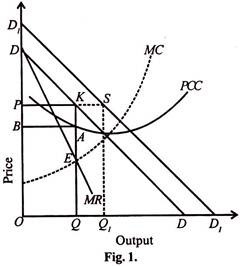In this article we will discuss about the shape of the advertising cost curve.
Incremental advertising costs if drawn as a curve will first decline, will be constant over some range of output and then will rise at an increasing rate. This is due to the operation of the economies of scale. Advertisement outlays may be in fixed proportions or in varying proportions. Sometimes both the methods may be combined. Economic theory usually deals with the U-shaped cost curve.
Therefore, advertisement outlay is also assumed to show three stages. The three phases of the advertising outlay namely, the decreasing, constant and increasing phase can be explained in the following manner.
Under usual conditions of static analysis, it is reasonable to assume that when an advertising outlay is increased, its unit cost first declines then levels to a minimum and thereafter rises. In other words, the advertising cost curve takes a U-shape.
ADVERTISEMENTS:
The declining phase of the curve is partly explained by economies of specialisation. Longer appropriations may make feasible the use of expert services and more economical media. More important than specialisation usually are economies of repetition. Often repetition of a particular advertising strategy becomes more economical.
The rising phase of the advertising cost curve is caused primarily by tapping successively poorer prospects as the advertising effort is intensified. A firm is generally forced into such a situation when
there is keen competition. The rise in advertising outlay may also be due to progressive expansion of the most efficient advertising media.
The short run marginal advertising cost curve will probably have the same form for all commodities regardless of their elasticity of promotion. The shape of the curve is determined by variations among prospects in accessibility and in susceptibility to advertising and by the diminishing utility of additional units of the product to any one user. The relationship of advertising to sales is more intricate than short run marginal analysis indicates. The selling cost function will differ with the nature of the business strategy involved.
In the above analysis, we assumed production cost to be constant in the short period. We have also assumed constant price which implies that average and marginal revenues are constant. However to be more realistic we have to introduce an average cost curve that slopes upward and an average revenue curve that slopes downward.
ADVERTISEMENTS:
A sloping average revenue function introduces complications, since both price and advertising are then variable. It is possible to keep the advertising costs constant and vary the price, or to keep the price constant and vary the advertising costs. This is what is done by Chamberlin. Chamberlin was the pioneer in attempting to include the economics of advertising in the general economic principles.
As a second step, both the advertising costs and price are varied simultaneously. This was done by Buchanan. He uses the downward sloping demand curve and the corresponding marginal revenue curve (MR) and arrives at the optimum price with the help of the production cost curve (PCC). He then assumes various advertising outlays. Every advertising outlay is expected to raise the demand for the product. Such an advertisement cost curve is explained below.
Advertisement is based on the assumption that there is quite a large number of customers who are prepared to change the brand which they are using. But this is not always true. Sometimes the people stick to those brands of goods which they have been using for a long time. But in any case, advertising costs are likely to increase the sale of a commodity.
They would induce the old customers to buy more and at the same time attract some new customers as well. Thus the advertising costs are likely to raise the demand curve of a commodity. To illustrate, a firm’s original demand curve is DD in Fig. 1 and its corresponding marginal revenue curve is MR. PCC is the production cost curve inclusive of advertising costs. Now the output is OQ and the price is OP. Profit is PKAB.
To get more business, some more advertisements are made by the firm. The additional cost of getting more business through advertisements must be atleast equal to the additional profit. As the result of additional advertisement, the demand curve shifts to the right as D1D1. The horizontal distance KS between the old demand curve and the new demand curve is the result of advertising.
The firm now sells more output OQ1 at the same price OP and its profit also increases due to higher sales. (Profit not shown to keep the figure simple). If a series of curves are drawn and joined together, we get the price output curve against the advertisement. Here the assumption is that the advertiser knows the effects of his outlay on sales.
